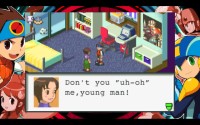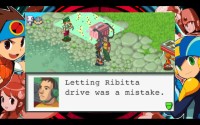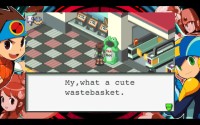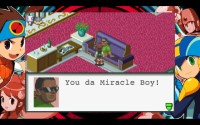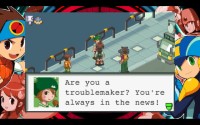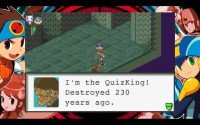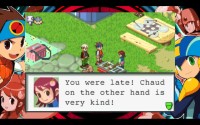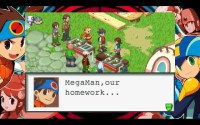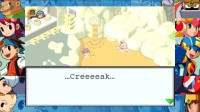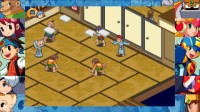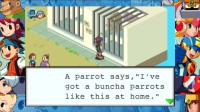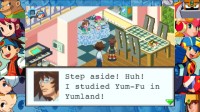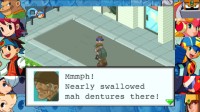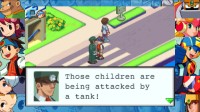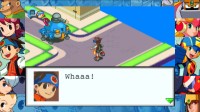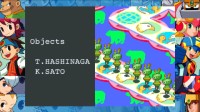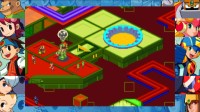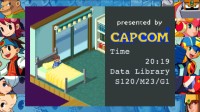Megaman: Battle Network
Battle Network 1 Playtime: 13.5 Hours
Finished 01 May 2022.I played the DS "remake" of this, Operate Shooting Star (not a typo) which includes a number of enhancements and fixes, so I never suffered through the original MMBN1. Apparently this game was a lot shorter than I remember it being - finished at Level 75, which is probably missing a number of PowerUps and HPMems. I believe this is the only game where the UnderNet is available near the beginning of the game - and farming top-tier chips clearly made most of the game quite trivial, as seen by the extremely short playtime. I don't remember much else about this game at the time of writing this.
Battle Network 2 Playtime: 25.0 Hours
Finished 14 June 2023.Starting from MMBN2, I'm playing the games on the legacy collection through Steam. I was able to get to Level 91 in the endgame of this one (clear file missed one PowerUp in MotherComp) and 5 HPMems that I didn't get, mostly from vendors. Also did all 18 sidequests from the request board, and ended with 149/250 chips in the library. I pretty much just did the main story and dropped it right after - postgame stuff tends to be really tedious without much actual content other than refighting Navis a ton.
My folder was primarily focused around the E and G codes. For E, I got a ton of Elecswrd and Elecblde chips, and had a good stock of AreaGrabs handy to put Megaman in range to use them. Those chips were super helpful since the UnderNet was mostly ice/water in this game for some reason. The G code started out as a great general-utility code containing Gutsman, Satellite, and HeatShot - but eventually became a Navi-specific code with lots of GateMan (for the Gater PA), GutsMan, and GateManSP (download chip, just a free 300 DMG). This handled most of the game very well, but some of the final fights were annoying. I was also lucky enough to get AquaCust as my first style, which is probably one of the best styles to get early on - I used it for almost the entire rest of the game.
Battle Network 3 Playtime: 20.3 Hours
Finished 29 October 2023.Played Blue version since it was released after White, with some changes and improvements. There are some important differences (like FolderBak vs NaviRecycle) but those generally seem to take place beyond the scope of the base game, which is where I stopped since I have no interest in the postgame. Now that regular buster upgrades are gone, the ending "level" can only really be gauged by HP values - I had 800 by the end (so missing 10 HPMems) and used Elec Cust style the entire game which ended up being quite good. Ended with all main-game sidequests done (up to Request #22), 144 chips (S120/M23/G1).
This time, my folder was focused on the F and P codes - mostly for FlashMan and Punk; I also used the X code for BassGX which is pretty much a 700dmg instakill on most stuff in the game. This was a pretty unfocused folder; there were a lot of swords, some area control, a few RockCube + Airshot combos (with Bolt as additional utility) - outside of a solid dual-code setup, my strategy in most fights was to just try to make the best of my random draw with varied results. I used both of the download chips and also grabbed the Lotto Codes for some good stuff there, which makes this a "cheater run" so to speak - fine by me as long as it gets me through the game.
The Battle Network games are really cool spinoffs of the main Megaman games for the GBA, taking place in a separate fictional world where the Robot Masters are instead "Navis" operated on the net by humans, kind of like AI personal assistants. They all star a perpetually 10-year-old boy named Lan who operates Megaman.EXE, and the plots generally focus on various cyber-terrorist groups hatching evil schemes to destroy the real world somehow. For the most part, the stories don't actually make much sense as these organizations are all toppled by a single elementary schooler, who subsequently seems to completely forget all of his abilities (and lose all of his battle chips) between each entry... trying to rationalize it all would only lead to lost braincells; these games are not meant to be taken seriously at all. The writing tends to have a rather comedic voice, and plenty of absurd situations and dialogues - the Mr Progs in particular have plenty of highlights.
Rather than just the setting, the main draw of the series is its very interesting gameplay, combining a semi-open-world format of exploration with a novel battle system which hasn't been replicated in full form (outside of One Step From Eden, which isn't really the same genre otherwise). Each battle puts the player into a 6x3 battlefield instance against enemies (termed "viruses"), split into 2 3x3 sections controlled by the player and enemies, each of which can generally move freely on their own side depending on the conditions of the tiles on the field. This occurs in real time, so Megaman needs to be moved around the battlefield to dodge incoming attacks while moving into position to strike back.
In addition to the battlefield layout, the second unique factor of the gameplay is the use of a folder of special attacks, or "chips" - this game is effectively a deck builder. Through fights, gifts, vendors, and random loot, Megaman can find additional chips over the course of each game with powerful effects, like bombs, cannons, swords. Then, at the beginning of each round of a fight, some of these chips are randomly drawn and can be selected, then executed during the round to attack (just like drawing and playing cards). Most enemies will have a corresponding chip they drop which allows Megaman to more or less duplicate their attacks and behaviors during battle - comboing many of these chip attacks together is crucial for allowing Megaman to control a fight and delete the viruses. Major boss characters, which are usually enemy Navis, can also drop special chips with particularly powerful attacks that can be added to Megaman's chip deck sparingly.
All in all, the entire MMBN series is a really fun series of games with mechanics seen nowhere else before or after, with a very amusing tone stemming from the ridiculousness of the stories and the absurdity of the events of each game. While I'm personally not good enough to do the postgame in pretty much any of these (as these games can very quickly scale to some extreme difficulties), I've consistently enjoyed playing through most of the main game of each entry that I've touched so far - though I do usually start to tire a bit near the end towards the final areas and bosses. There is certainly no shortage of issues common to some or all of the games (and I imagine I'll be ranting about them to no end below), but at the end of the day they're an experience that can't be found anywhere else.
This game has so many critical improvements over the first, making it so much more playable on average than even OSS - this is probably the biggest jump in quality between any 2 games of the series, outside of maybe BN5-BN6 (the balance shifts there are also absurd in the player's favor). The addition of the star codes by themselves make folders inherently more versatile, making double or even triple-code folders far more reasonable to use than before. I will note that the OSS remake of BN1 did have a very limited implementation of these too, which is probably why I didn't notice as much of an impact when I moved from that to this. Health is also now persistent across battles and only resets when jacking out (or in a few specific scenarios besides), which is counterbalanced by the enemies in this game doing FAR less damage. Instead of dying in just a couple of hits, you can screw things up royally and still make it out alive. Also, the boss fights and timing in general tend to be far more fair than in BN1, which is very nice as well. The V1 forms don't ever take more than a couple of tries to beat with a decent folder, but the V2 and V3 forms get exponentially harder - unlike the later games in the series, fights do not seem to escalate any further (ie. no EX, SP, DS versions).
However, there are still a number of problems from BN1 that weren't resolved - many of which I imagine will still plague a number of the following games in the franchise. The tooltips in this game (pressing LB allows Lan to talk to Megaman.EXE for hints and advice) are completely useless, and almost never contain any relevant information. It completely falls short of providing any hints, and usually even of understanding what I'm supposed to do... most of the time, Megaman's dialogue effectively amounts to "Oh no!" - how the heck am I supposed to understand what my objective is? If I decided to take a break from this game and come back later, I guarantee I wouldn't have any idea where to go regardless of what part of the game I paused at. What amplifies the above issue and truly makes the game miserable to play is the excessive backtracking in this game, which is a common theme across the entire series actually - mostly due to the quick turnaround on each entry. So not only are you lost, but you don't even have the intuition of poking around the newest area, since most of these objectives are spread out across the world. In particular, FreezeMan's scenario pretty much dashed any hopes of me ever wanting to play this game again.
The balancing of individual battles also has a number of serious faults. First and foremost, the drop tables are absolutely horrendous in this game. For the requirements of getting Rank 8+, hitting those in normal fights should NEVER give you random money - you should get a chip 100% of the time beyond that. Even worse, getting rank S just to receive a shitty amount of money about 30-40% of the time is insulting. It's hard to care about building up an interesting deck when the game just never wants to give you the chips to do so. There's even a number of hidden conditions, particularly in that different health ranges will give different sets of codes - the tables are separate below 25% and above 75% HP.
Secondly, a number of enemies are just not fun to fight - I'm thinking of the Shadows and Dominerds in particular, both of which are garbage enemy designs. Shadows are completely immune to everything except sword attacks, meaning that it's pretty much guaranteed you'll be spending multiple rounds shuffling through your deck to find the few sword chips that can even touch them. Thankfully, I had a hefty number of them (since I knew it was coming) but still didn't enjoy any of those encounters. On the other hand, Dominerds completely freeze the pace of battle because of their extremely limited vulnerability, and due to their high health will frequently take multiple chips to kill. Encountering more than one at a time basically guarantees you'll be sitting around for a long time with nothing to do. For a game focused on fast battles, these are pretty much the antithesis of fun within the gameplay formula. The worst part is that these both come back in the next games, so I'm nowhere near done with them yet.
Thankfully, the game has a very powerful PA that can be obtained easily very early into the game - the Gater PA can be used (and abused) from the second you get the GateMan chip by combining it with Wind and Fan (sequence Wind-Fan-GateMan, think push-pull-GateMan). It basically grants a free 900 damage to anything that isn't blocked by an obstacle or immune to projectiles; this damage is also distributed in 100-damage increments to all enemies on the field allowing for a free instant clear of almost every fight in the game. I used it a decent amount in the midgame, but started to move away from it later to focus the folder more on the ElecSwrd combos which were also a lot of fun in my opinion. However, the number of invincible enemies or otherwise shitty & slow fights started to drag on near the end of the game, so I ended up cheesing a number of very late fights by resetting to get Gater or other good combos, or simply just BusterMAXing random V2/V3 fights (if I didn't plan to use the chips). I did the same with the final boss, because by that point I was completely burned out... I don't really feel to guilty about it, since it's pretty much a series staple at this point for the final bosses to be garbage.
I'll close this section by going into more detail about the legacy collection through which I played this. I had originally intended (a year or so ago) to play this on a GBA emulator as I did when I was younger, but didn't really get around to the following games after finishing OSS. If I had done that, I probably would have spammed savestates as I always do on GBA Emu for the BS fights. However, this collection doesn't have that feature, instead replacing it with a "BusterMAX" mode, which multiplies your regular buster attack by 100 (not charge attacks, interestingly). I ended up enjoying the regular playthrough with the option of BusterMAX more than the theoretical emulated playthrough, since it feels a bit too cheap to simply mitigate any kind of damage, etc. in the middle of a fight - and I feel like I was more judicious with my abuse of BMAX overall. Also, since you can't fuck up savestates, I didn't have to worry about accidentally saving in a bad spot or over an important state and losing progress, so that made my playthrough a lot smoother and more relaxed. Even despite my ranting, I still had a great time in this game.
This game marks the end of the first 'trilogy' of the Battle Network games. From what I understand, the original plan with this spinoff series was to end Lan's story here, hence why the game ends with him graduating elementary school and Megaman.EXE's rebirth. Obviously, due to the popularity of the games they decided to continue the series with entries 4-6, and afterwards another trilogy of spiritual successors on the DS in the form of the Star Force series. It's kind of interesting to come back and play this now with that perspective, because BN3 introduces one of the most distinctive mechanics of the series with the introduction of the Navi Customizer - being able to configure Megaman with specific powerups to your playstyle instead of having raw upgrades as in 1-2 was a huge change, ultimately for the better. The hidden mechanics of compression and bugs (+ exit codes to fix bugs) are really cool nods to the cyberspace theme of the game too. It's also the first time in the series that there are two different game versions, obviously trying to replicate Pokemon's success in selling you two of the same thing. Differences here are very minor though, limited just to a couple of chips and Navis - nothing worth caring about for me.
In most other ways though, this game doesn't tend to distinguish itself too far from BN2. By this point in the series, the core gameplay elements were already ironed out so changes started to become a bit more incremental mechanically. Compared to some of the later games, I can say that the Navi fights in this game generally suck and are simply not fun, and the NaviCust mechanic is leveraged a bit too heavily. Having to constantly swap in the Press/BlackMind/EnergyChange to complete dungeons or even navigate around areas is a miserable experience and heavily discouraged me from trying to spend time making interesting setups, as I'd have to break those every time I wanted to access areas like Yoka or the Undernet. The style changes are cool as usual, but definitely feel less effective overall since you have to waste a ton of space in your NaviCust to properly buff up your charged shot.
The story this time around ramps up from the scale of the earlier games somewhat - again, as a direct continuation of the story from 1-2, some of the same characters appear in this game which could theoretically spoil things if you weren't already familiar with the series. It's pretty cool that you actually get to fight Bass for real in the main story of this game though, since he's usually sequestered away as the final superboss encounter that I can't ever be bothered to aim for. I cheesed the entire final boss sequence so never really had any problems with it, but I'll admit it's a neat sequence and would have served as a climactic ending for the series, taking down both Bass & Wily and having a brief chance to talk to Dr. Light. Beyond a few sentences of summary though, BN3's story is about as nonsensical as would be expected from the earlier entries; it's never really explained in this series why a 10-year-old needs to save the world every one of these times. I think the translation is exceptionally bad in this one though, since lots of text doesn't even have proper punctuation or grammar. It's probably best to not think about the story when playing these games anyway, so I had the Humor program permanently loaded on Megaman just because.
Overall, I think this is probably my least liked out of the first trilogy of battle network games but still more than enjoyable enough to finish once. As mentioned in the status section, I did kind of "cheat" by using the download chips available in the legacy collection and also grabbed all of the lotto codes, but for me it made playing the game actually bearable. I think that this game tends to be one of the most liked of the series simply because there's a ton of stuff to do and grind for in the lategame and postgame that simply doesn't exist in the rest of the games. There's a whole sequence of fights and events you can go through to attempt Serenade, the true ultraboss in this game and the only other being in the MMBN universe who has canonically defeated Bass. I suppose that's cool and all, but I really don't like the postgames of this series anyway so this doesn't affect my opinion much. One other thing - I chose Blue version because it is technically "better" with access to an absurdly powerful Gigachip (FolderBak); however, in my case that made no difference since I didn't end up getting it. I wonder how the version differences manifest in the later games, whenever I end up playing them.
